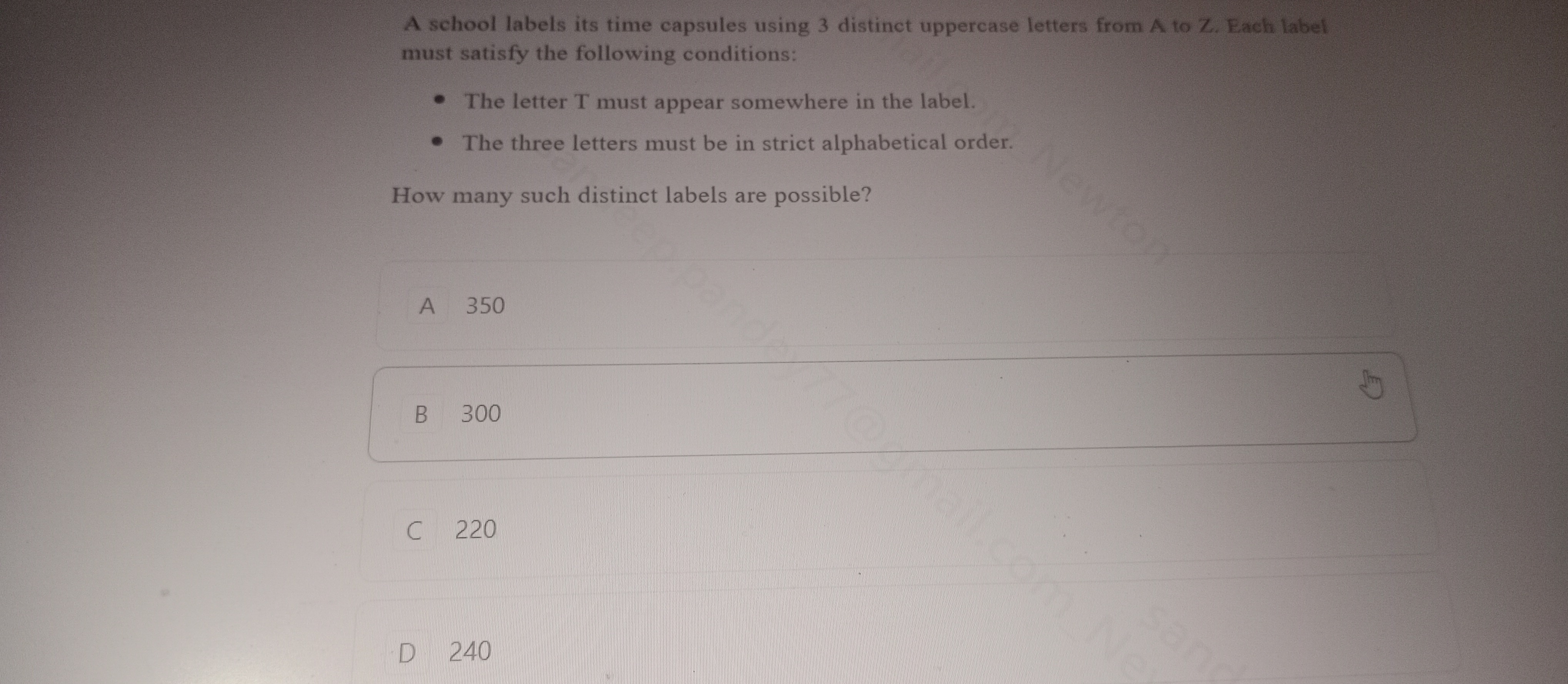Question
Question: A school labels its time capsules using 3 distinct uppercase letters from A to Z. Each label must sa...
A school labels its time capsules using 3 distinct uppercase letters from A to Z. Each label must satisfy the following conditions:
- The letter T must appear somewhere in the label.
- The three letters must be in strict alphabetical order.
How many such distinct labels are possible?

350
300
220
240
300
Solution
Let the three distinct uppercase letters be L1,L2,L3. The letters must be in strict alphabetical order, so L1<L2<L3. The letters are chosen from the 26 uppercase letters A to Z. The letter T must appear somewhere in the label. T is the 20th letter of the alphabet.
Let's consider the possible positions of the letter T in the alphabetically ordered label:
Case 1: T is the first letter (L1=T).
If L1=T, then the letters must satisfy T<L2<L3. L2 and L3 must be distinct letters chosen from the letters that come after T in the alphabet. The letters after T are U, V, W, X, Y, Z. There are 6 such letters. We need to choose 2 distinct letters from these 6 letters for L2 and L3. Once chosen, their order is fixed by the alphabetical requirement. The number of ways to choose 2 letters from 6 is given by the combination formula (kn)=k!(n−k)!n!. Number of labels in this case = (26)=2×16×5=15.
Case 2: T is the second letter (L2=T).
If L2=T, then the letters must satisfy L1<T<L3. L1 must be a letter that comes before T. The letters before T are A, B, ..., S. There are 19 such letters. L3 must be a letter that comes after T. The letters after T are U, V, ..., Z. There are 6 such letters. We need to choose 1 letter for L1 from the 19 letters before T and 1 letter for L3 from the 6 letters after T. The number of ways to choose L1 is (119)=19. The number of ways to choose L3 is (16)=6. Since the choice of L1 is independent of the choice of L3, the total number of labels in this case is the product of the number of ways to choose L1 and L3. Number of labels in this case = (119)×(16)=19×6=114.
Case 3: T is the third letter (L3=T).
If L3=T, then the letters must satisfy L1<L2<T. L1 and L2 must be distinct letters chosen from the letters that come before T in the alphabet. The letters before T are A, B, ..., S. There are 19 such letters. We need to choose 2 distinct letters from these 19 letters for L1 and L2. Once chosen, their order is fixed by the alphabetical requirement. The number of ways to choose 2 letters from 19 is given by the combination formula. Number of labels in this case = (219)=2×119×18=19×9=171.
The three cases cover all possible labels that contain T and are in strict alphabetical order. These cases are mutually exclusive. The total number of distinct labels possible is the sum of the numbers from the three cases. Total number of labels = (Number of labels with T as L1) + (Number of labels with T as L2) + (Number of labels with T as L3) Total number of labels = 15+114+171=300.
Alternatively, we can calculate the total number of distinct labels with 3 distinct uppercase letters in alphabetical order and subtract the number of such labels that do not contain T. The total number of ways to choose 3 distinct letters from 26 letters and arrange them in alphabetical order is (326). (326)=3×2×126×25×24=26×25×4=2600. The number of distinct labels with 3 distinct uppercase letters in alphabetical order that do not contain T are those formed by choosing 3 letters from the 25 letters excluding T. The number of ways to choose 3 letters from 25 is (325). (325)=3×2×125×24×23=25×4×23=100×23=2300. The number of labels containing T is the total number of labels minus the number of labels not containing T. Number of labels containing T = (326)−(325)=2600−2300=300.
Both methods give the same result.
